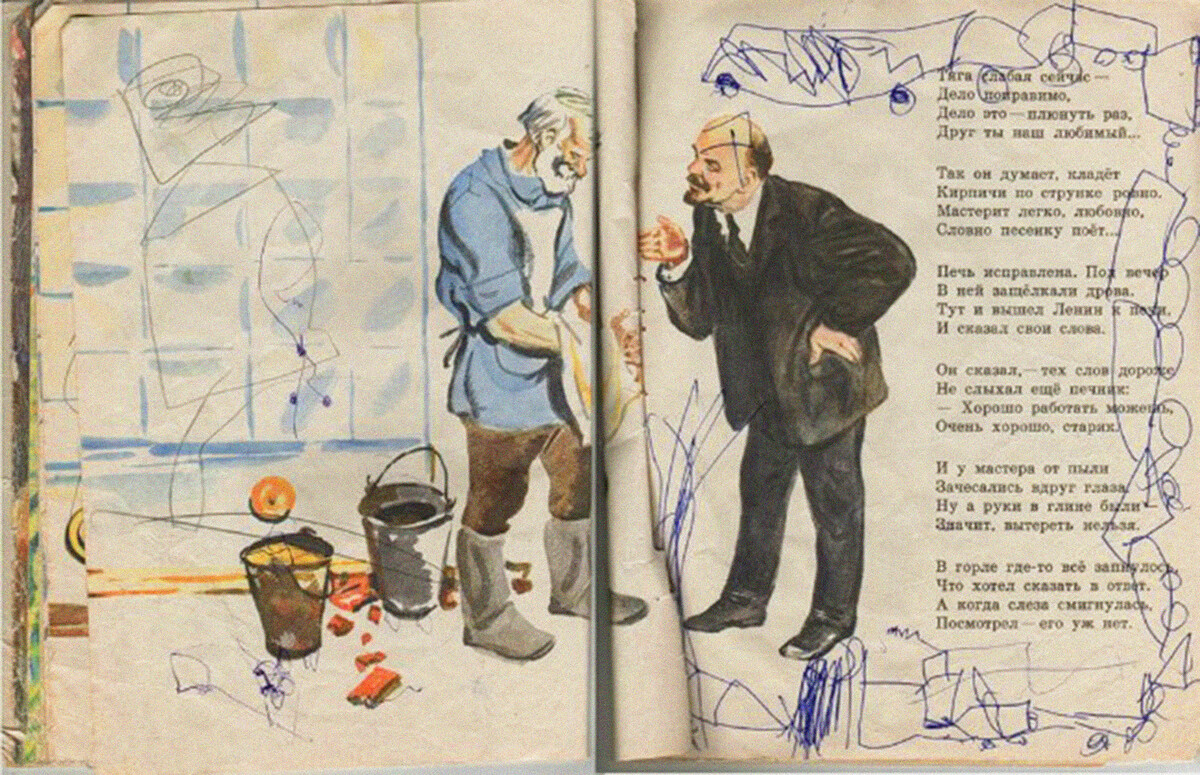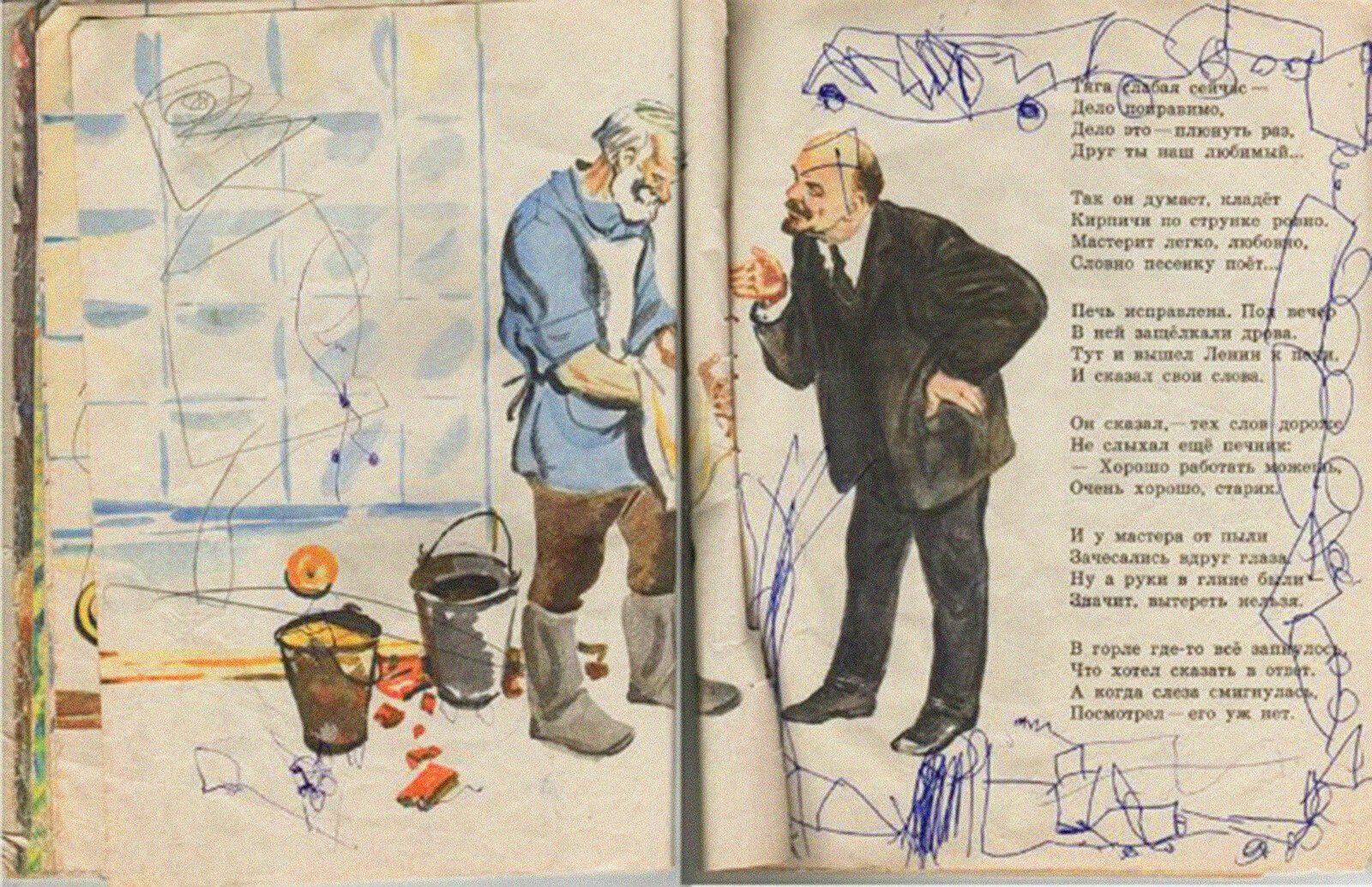Oh I believe in miracles
Oh I believe in a better world for me and you
—The Ramones
In the 1990s, right after the collapse of the USSR, the Russian tabloid press burst into a huge series of exposés on leaders of the state socialist past. A lot of this attention fell on Lenin—as the founder of the state, he became a privileged target of all sorts of attacks. Historians and journalists competed to reveal unknown, weird, or unpleasant facts of Lenin’s biography. This genre is still alive, and seems to replace—or simply invert—an old Communist legacy: everyone who, like me, was born in the Soviet Union, can still recollect a number of stories from Lenin’s life. Among them are stories of: Lenin deceiving the police officer who came for a home inspection,1 Lenin writing secret messages to his comrades from prison,2 Lenin inviting a stoveman for a cup of tea,3 Lenin meeting a beautiful red fox in the forest.4 In these Soviet legends, the leader is always portrayed as positive and gentle, whereas post-Soviet texts represent him as a negative or extremely ambiguous figure. One recent essay of this latter kind suggests that Lenin’s ancestors came from Western Europe, more specifically from Germany. A recent article digs further and claims that someone in the line of Lenins, perhaps the leader’s great-grandmother, was defamed for using black magic and witchcraft, and was burned at the stake by the Inquisition.5
Given the number of people massacred for this “crime” from the fifteenth to the seventeenth centuries, this story might very well be true. My goal, however, is not to investigate the historical veracity of this claim and determine whether Lenin was indeed a descendent of this enigmatic woman. Rather, the very idea that the revolutionary leader could have had an ancestor who was a witch, sorcerer, or magician in intriguing to me: the superpowers which, as a Soviet child, I imagined he had could have been inherited from someone who fell victim to the genocide committed under the banner of Christianity amidst the rise of capitalist modernity.
This coincidence does not seem random. In Caliban and the Witch: Women, the Body and Primitive Accumulation, Silvia Federici brilliantly explains capitalism’s birth from the spirit of the Inquisition. Federici presents the figure of the witch “as the embodiment of a world of female subjects that capitalism had to destroy: the heretic, the healer, the disobedient wife, the woman who dared to live alone, the obeha woman who poisoned the master’s food and inspired the slaves to revolt.”6
Behind the witch hunt, she uncovers a joint effort by the Church and the state to establish mechanisms of gendered control of bodies that immanently resisted newly instituted regimes of productive and reproductive work.
“No one yet has determined what the body can do,” said Spinoza in his 1677 Ethics. However, the nascent capitalist system determined what the body must do: it must work. According to Federici, in the transition from feudalism to capitalism the multiple powers of the body were transformed into a calculable and controllable work-power. This transformation required the destruction of the conception of the body “as a receptacle of magical powers that had prevailed in the medieval world,” in which the lines between Christian religion, magic, and the remains of paganism were still not clear. Precapitalist bodies felt themselves connected to nature and the stars in various ways: the Malleus Maleficarum (the Hammer of Witches) arrived in 1487 to sever these ties. As Federici puts it: “The body had to die so that labor-power could live.”7 The death of the body meant cutting off any magical potential that did not fit into the scenarios of capitalist development. The “age of reason” chased out magic, queer, female, and animistic lifestyles, just as, in Foucault’s analysis, it excluded madness.8 Foucault showed how madness was targeted by police measures, which criminalized it along with other forms of workless life. Federici adheres to this Foucauldian approach of uncovering the genealogy of power, placing greater emphasis on it than conventional Marxist and feminist analyses. She states that witches do not work either; they are engaged in alternative activities, and this is their main crime against the bourgeois order. As Federici explains,
A variety of practices were designed to appropriate the secrets of nature and bend its powers to the human will. From palmistry to divination, from the use of charms to sympathetic healing, magic opened a vast number of possibilities. There was magic designed to win card games, to play unknown instruments, to become invisible, to win somebody’s love, to gain immunity in war, to make children sleep … Eradicating these practices was a necessary condition for the capitalist rationalization of work, since magic appeared as an illicit form of power and an instrument to obtain what one wanted without work, that is, a refusal of work in action … Equally incompatible with the capitalist work-discipline was the conception of the cosmos that attributed special powers to the individual: the magnetic look, the power to make oneself invisible, to leave one’s body, to chain the will of others by magical incantations … The incompatibility of magic with the capitalist work-discipline and the requirement of social control is one of the reasons why a campaign of terror was launched against it by the State.9
The capitalist conception of the world implies that all the body can do is work, and it is only through work that the needs of that body can be satisfied. “Capitalist ethics, a pitiful parody on Christian ethics, strikes with its anathema the flesh of the laborer; its ideal is to reduce the producer to the smallest number of needs, to suppress his joys and his passions and to condemn him to play the part of a machine turning out work without respite and without thanks,” wrote Paul Lafargue.10
However, this has not always been the condition of our bodily existence. There was a time when the body was conceived as an intersection of cosmic forces and a part of the natural whole in which everything is related to every other thing. Federici again: “At the basis of magic there was an animistic conception of nature that did not admit to any separation between nature and spirit, and thus imagined a cosmos as a living organism, populated by occult forces, where every element was in ‘sympathetic’ relation with the rest.”11 A miracle might have violated the laws of nature, but it did not violate the whole of magical being and thinking. At a certain point, this became impossible. Under capitalism not only did the economic system change, but also, as Federico Campagna claims in his book Technic and Magic, the very composition of the world its metaphysical presuppositions:
The character of our contemporary existential experience points towards a certain type of ordering of our world, and of ourselves within it. This ordering is superficially social/economic/etc., but in fact derives from a set of fundamental metaphysical axioms. These axioms combine together in an overall system, which is the reality-system of our age. A reality-system shapes the world in a certain way, and endows it with a particular destiny: it is the cosmological form that defines a historical age. At the same time, however, it is also a cosmogonic force: its metaphysical settings and parameters actually create the world.12
Campagna differentiates between two great reality-systems or “cosmogonic forces”: he calls them “technic” and “magic.” From this perspective, one can say that the age of reason—or the age of capitalism, whose advent, according to Federici, coincides with the emergence of witch hunts and the eradication of alterity—is defined by the metaphysical parameters of technic: representation, abstraction, separation, etc. Within these cosmological conditions, miracles are “technically impossible” (they might be possible in an alternative reality-system). The first constitutive principle of this system is the presence of the “ineffable” dimension of existence, “which cannot be captured by descriptive language, and which escapes all attempts to put it to ‘work’—either in the economic series of production, or in those of citizenship, technology, science, social roles and so on.”13 Magic introduces, according to Campagna, a sort of therapy for the pathologies of our existence in the technic reality-system, such as the foreclosure of the future and the general feeling that we are incapable of building an emancipatory project that would fundamentally change the direction of history. A therapeutic injection of magic, suggests Campagna, is key to overcoming this situation.
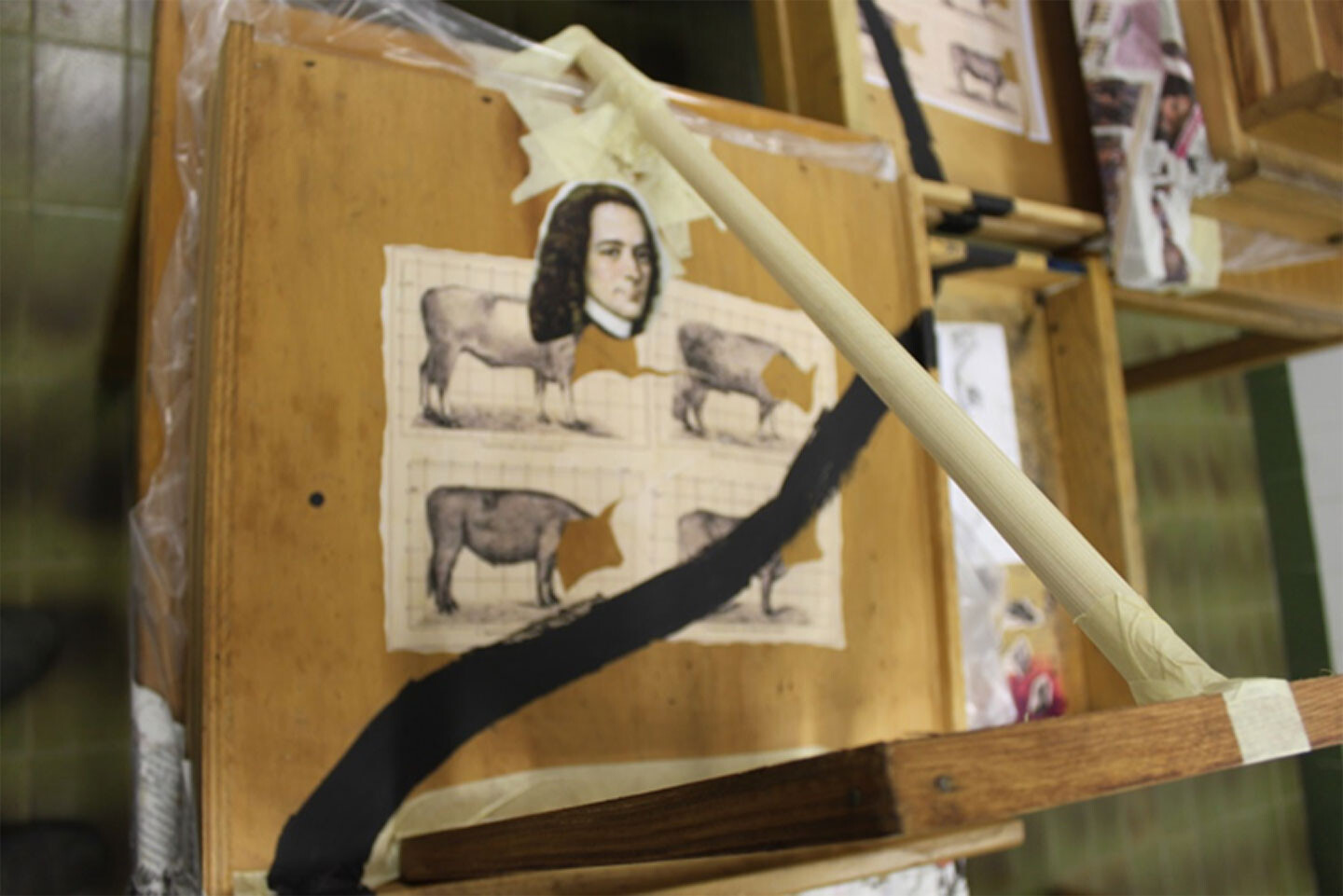

Nikolay Oleynikov, Oslobodenje: The Burlesque Museum, 2015. Installation views from Konjic Biennial, Bosnia and Herzegovina.
I would like to respond to this call with my own theory of witchcraft—well, not really a theory, but instead brief notes towards a theory that might then be fleshed out by anyone. These notes are conditioned by my personal experience of being a child who was so scared of the dark that the only way to overcome the horror was to let myself be fully absorbed by this darkness, to identify with it. I’m sure I’m not the only child who has used this tactic to deal with her fear of the dark. When I realized that the source of my fear was not outside of me, but within, I felt ecstatic. I thought I could become a magician if I learned to be more attentive to the darkness that was a part of me.
A child might feel the desire to become a magician when the world, which at first seemed to be so loving and gentle, ceases to comply with her every need, and instead starts to live a life of its own. The child’s mother, who just a moment ago was reading her a fairy tale, must now leave for work; left alone in her cradle, the child helplessly waves her hands, trying and failing to call her mother back. At a certain point, it turns out that the desires of the child are not the one and only law for her parents, who sometimes have to obey other laws—laws that are indifferent to the desires of the child. This experience is catastrophic, but at the same time a necessary and constitutive, rupture between the world and the subject. Starting in our early childhood we gradually realize that when it comes to the world and the subject, things can go terribly wrong. Everyone has their own way of dealing with this existential mess.
I want to propose two paradigmatic strategies that people use to negotiate the competing demands of desire and the law: religion and magic. Religion helps one conform to the world, subordinating desire to a codified law. Magic, by contrast, invites one to make the world conform to one’s own desires, subordinating the law to the subject’s arbitrary rule. Accordingly, our culture knows at least two types of spiritual practices; these can be illustrated by the two different paths that a child who wants to become a magician might take. In one, the child turns to religion, establishing a relation of exchange with God and expecting the latter to grant her wishes. In the other, the child establishes a relation of exchange with the Devil instead; she gives him her soul, and in return he gives her the ability to become a master magician and grant any wish herself.
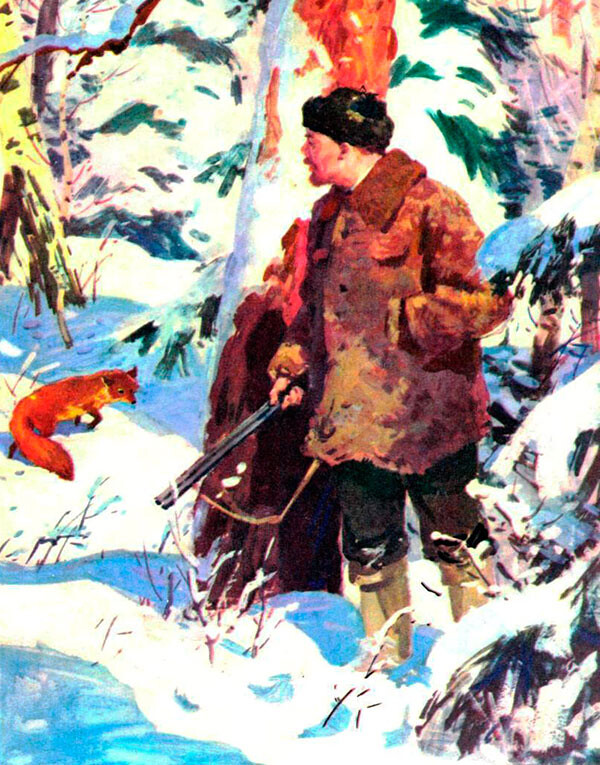

From a Soviet children’s book, illustration by D. Khaikin of Lenin chasing a fox.
The child who becomes a magician is ready to make an inhuman effort to force the world to conform to her desires. She becomes a witch out of injury, resentment, weakness, despair, melancholy, envy, jealousy, loneliness, the irreversibility of death, or poverty. (When I was poor, I wanted to use sorcery to obtain five hundred rubles so that I could buy a sweater.) She also becomes a magician out of boredom, just to avoid being a philistine. The main source of her magic force is her firm belief in herself, which she perhaps acquires at precisely her worst moments of loss and catastrophe. She desperately wants, at any cost, to do what others cannot—awaken the dead, bring a lost loved one back to life, enact revenge, turn back time and redeem a fatal error committed in the past. A person who becomes a magician has learned that something is fundamentally wrong—the world is unjust, and this order of things can, in fact, be changed miraculously. A magician challenges the order of things dictated by God and nature. If the essential injustice of this reality—the domination of the rich over the poor, the strong over the weak, the living over the dead—is a law, she wants to transgress this law and impose her own will in its place.
A witch needs certain skills and superpowers that exceed those of ordinary humans, in order to grant her own wishes or those of others. This requires the witch to interrupt the order of things, transgress the law, and break through the inertia of so-called normal life. Witchcraft starts at the limit of the possible, where the competence of ordinary people ends. It is forbidden because the very fact of being a witch violates natural and social law, which allocates a place and time to everyone and everything. There are cracks and holes in reality that witches plug up with their own bodies. Witches are thus alien. They belong, in part, to another world in which the law is not applicable. But they also belong intimately to this world, which they try to change or fix; they therefore still depend on the laws which they suspend.
Deleuze and Guattari write that “sorcerers have always held the anomalous position, at the edge of the fields or woods. They haunt the fringes. They are at the borderline of the village, or between villages.”14 But sorcerers not only exist at the border: as anomalous beings, they are the border itself. In other words, the borderline passes through their bodies. In Deleuze and Guattari’s framework, this borderline runs between two multiplicities, or two packs. The anomalous individual belongs to neither of these packs, but instead enters into secret alliances: “The important thing is their affinity with alliance, with the pact, which gives them a status opposed to that of filiation. The relation with the anomalous is the one of alliance. The sorcerer has a relation of alliance with the demon as the power of the anomalous.”15
However, the border between two multiplicities is not the only border where witches can be found. I would like to complement Deleuze and Guattari’s schema with three additional kinds of borders, which I first outlined some time ago: 1) the border between something and a similar thing; 2) between something and a different thing; 3) between something and nothing.16 I am particularly interested in the third border, where we face the ultimate edge of the world. Locating the witch at this border can help us understand how miracles works.
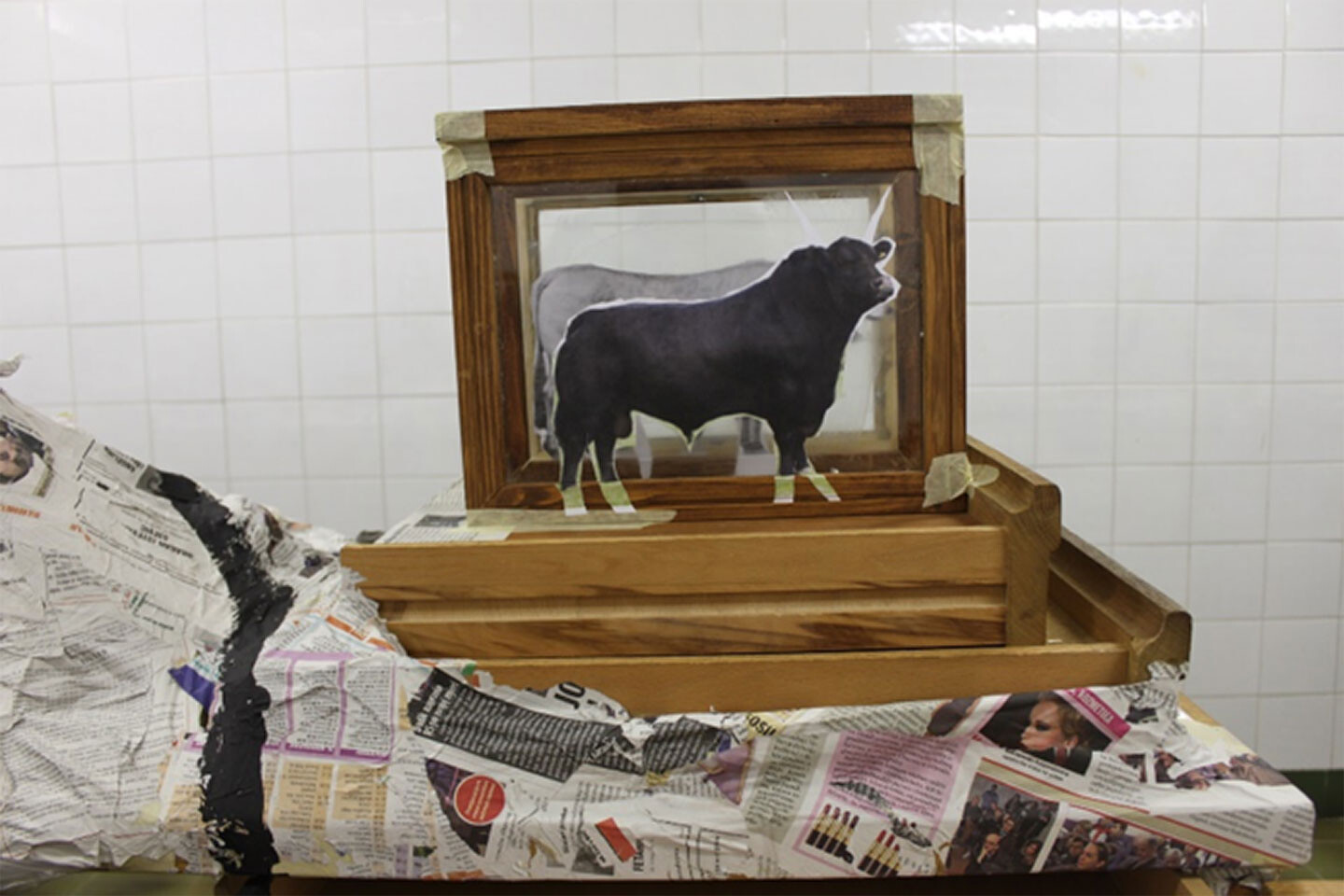

Nikolay Oleynikov, Oslobodenje: The Burlesque Museum, 2015. Installation views from Konjic Biennial, Bosnia and Herzegovina.
If we consider the “real” world as a unity of things (okay, you can call it a multiplicity, but still, within its border it functions as a kind of unity), the witch definitely breaks up this unity in a freaky way, while also being part of it. On the one hand, the witch secures this unity by using her body to fill in the holes in being. On the other hand, she breaks it—behind her back there is either another world, whose agency she represents, or there is nothingness. It is said that witches do not have a back. I think that having no back means precisely that there is nothingness behind the witch. This is why it’s so difficult to hunt her. The moment she turns her back to you, she disappears.
As Federici shows, the persecution of witches was an instance of gendered violence on a massive scale. The victims were overwhelmingly women. However, I would like to differentiate between real victims of the Inquisition who were accused of witchcraft, and the witch more generally, or the magician, or the sorcerer—the border figure, whose body is neither male nor female, neither animal nor human, neither young nor old, neither alive nor dead. In my view, this figure is perfectly queer. Think about witches in fairy tales. Baba Yaga, the witch from Russian folklore, is a ferocious old woman who, by all appearances, exists on the border between life and death. It is said that her nose “grows into the roof,” which means that the wooden hut where she lives (at the edge of the forest) is as small as a coffin. Witches can transform into birds, frogs, snakes, and so forth—they can be anything, but the “real” world always remains intolerable to them. Between something that is and something that is not—that is, nothing—their bodies bear within them that active part of nonbeing that we call desire. Seeing a naked woman flying on a broom during the night, an ordinary human being might think that a witch’s desire is sexual. But it is more than that. A witch’s desire is ontological: it must be strong enough to transform something that is not into something that is, nonbeing into being (to trigger rain, to raise the dead). Such a transformation is a miracle.
Let’s return to Lenin and his great-grandmother the witch, who inspire me infinitely. Among the many things that Lenin surely inherited from her was his insistence that miracles are possible. It is possible to make something out of nothing—that is, to transform something that is not into something that is, to bring something into being from nonbeing. As noted by Ronald Boer—who, in his study Lenin, Religion, and Theology, sees in the notion of the miracle “a crucial dimension of Lenin’s approach to revolution”17—Lenin used to say that intelligent people do not believe in miracles that happen all of a sudden. At the same time, he developed an alternative conception of the miracle, insisting that people can perform them if they are enthusiastic enough, if they are driven and capable of making a supreme effort.
“Every man and every woman is a star,” said Aleister Crowley. In Lenin’s sense, every man and every woman is a miracle man and a miracle woman. There is something demonic in this: as Lenin sees it, miracles do not simply happen and they cannot be ascribed to God or to some other supreme being; they are performed by real people themselves. Lenin famously said that “a revolution is a miracle.”18
In his writings and speeches, Lenin clearly appreciates the miraculous aspect of great human endeavors—such as political struggle and hard work for the sake of socialist revolution. For Lenin, the radical breakthrough that is revolution is a “miracle.” In Badiou’s terminology, this kind of breakthrough is called an “event.” But in Lenin’s framework, “miracle” is the better word since it describes something that transpires precisely when that thing seems most impossible. People create miracles in a desperate attempt to overcome the state of impotence they face in a given situation. We never know in advance, we risk everything, and only then, retroactively, can we discern a miraculous dimension to our efforts.
In 1917, Lenin wrote:
There are no miracles in nature or history, but every abrupt turn in history, and this applies to every revolution, presents such a wealth of content, unfolds such unexpected and specific combinations of forms of struggle and alignment of forces of the contestants, that to the lay mind there is much that must appear miraculous.19
A dozen years prior, in 1905, he wrote in his Two Tactics of Social-Democracy in the Democratic Revolution:
Revolutions are the locomotives of history, said Marx. Revolutions are the festivals of the oppressed and the exploited. At no other time are the masses of the people in a position to come forward so actively as creators of a new social order as at a time of revolution. At such times the people are capable of performing miracles, if judged by the narrow, philistine scale of gradual progress.20
According to Boer, “Lenin’s overt usage of miracle lays its emphasis on human energy, effort and enthusiasm. Yet it requires stupendous moments for such miracles to occur, moments that evoke almost superhuman effort from those who did know they could do so.”21 I would like highlight Boer’s use of the word “superhuman.” There is a clearly Nietzschean aspect to Lenin’s politics: the human, the all-too-human being, is the subject who overcomes. Desperation can move mountains—we all know this, but we rarely dare. In Boer’s interpretation, a key part of Lenin’s equating of revolution with miracle is the tension between organization and spontaneity, between the so-called party avant-garde and the spontaneity of the people. Organization and spontaneity are two terms in dialectical opposition, and what appears miraculous is their synthesis. That is where political magic begins, and political technics ends.
We must make a crucial distinction between Lenin’s magic and the magic of the lonely child with whom I began. The novelty of Lenin’s magic is that miracles are brought about by collectivities of people rather than by individuals. In a materialist sense, the condition of possibility for Lenin’s miracle is collectivity itself. The superpowers of the magicians of revolution come from solidarity and comradeship. In my view, this solidarity and comradeship have something in common with witchcraft. Witchcraft transforms and renders impersonal the body of the witch, who is otherwise individualized, scrutinized, and punished by the witch hunt. Solidarity and comradeship, as forms of person-to-person attachment, also do away with individual identity. They are different than friendship and love, where the unique identities of the people involved is fundamental. In solidarity and comradeship, identity vanishes. I love this particular person, but my comrades are treated anonymously and equally regardless of who they are.
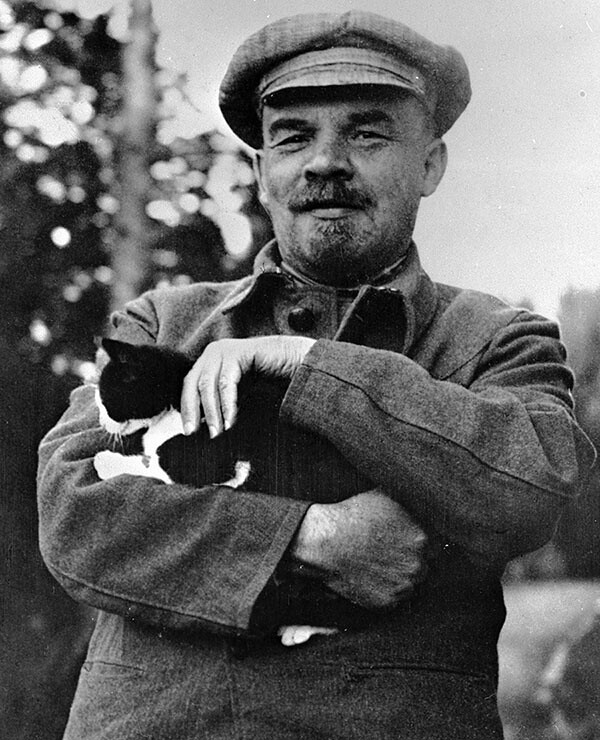

Vladimir Lenin caresses the purrletariat, date unknown. Photo: Maria Ulyanova/Sputnik.
Lenin and other so-called professional revolutionaries worked underground. This was called konspiratsiia. According to Lars Lih, in Lenin’s historical context konspiratsiia referred to “the set of rules by which you do not get yourself arrested by the police,” or the “fine art of not getting arrested.”22 One should not confuse konspiratsiia with “conspiracy.” As Lih explains, the logic of konspiratsiia is precisely the opposite of conspiracy: “A conspiracy means keeping information and knowledge within the small group, so that it can go and knock off somebody or lead a palace coup. Konspiratsiia is the opposite—it is about getting knowledge and ideas out to as many people as possible.” Lih paraphrases a passage from What Is to Be Done? that describes a concrete example of konspiratsiia:
Although a strike might not be secret to anybody in the town where it happens, people across the country might not know about it, so our task is to get that word out and let everybody know about it. But in order to do that we need people organising professionally in underground conditions in order to get the report, write it up, send it off to Geneva, where the paper is printed, and then smuggle it back into Russia again for distributing. This demands the logic of konspiratsiia—empirically worked-out rules for not getting arrested.23
Sometimes people forget that “Lenin” was the underground nickname of a person actually named Vladimir Ulianov. Bolsheviks in konspiratsiia lived faked social lives under fake names, constantly changing their passports, families, appearances, and even genders. What connected them was that they were all comrades. In her theory of the comrade, Jodi Dean suggests four theses that “articulate a generic political component activated through divisive fidelity to the emancipatory egalitarian struggle for communism”:
1. “Comrade” names a relation characterized by sameness, equality, and solidarity. For communists, this sameness, equality, and solidarity is utopian, cutting through the determinations of capitalist society.
2. Anyone but not everyone can be a comrade.
3. The Individual (as a locus of identity) is the “other” of the comrade.
4. The relation between comrades is mediated by fidelity to a truth. Practices of comradeship materialize this fidelity, building its truth into the world.24
According to Dean, “a comrade is one of many fighting on the same side.” I want to complement Dean’s theory by detailing some metamorphic and miraculous moments of comradeship. Comrades are replaceable. This aspect of the masquerade makes politics a theater, but a very special one, similar to Artaud’s theater of cruelty; here, ancient masks return, as they present a show, a ritual of direct and instant communication. The mask is more important than the face behind it (if there is one)—it directly communicates affect. We must understand that we live in a society in which individualism is recognized as a supreme value. Everyone is required to have an identity: we are identical in that we all have to be clearly identifiable. Comradeship, in the sense that I am trying to develop here, transgresses this rule: it breaks with identitarian ideology, it is destructive of the individual, autonomous person. In his conception of theater, Artaud attacks classical Western theater—where actors represent characters and so on—and instead advocates a “superior notion of the theater,” which he compares to a plague, a contagion:
The theater like the plague is a crisis which is resolved by death or cure. And the plague is a superior disease because it is a total crisis after which nothing remains except death or an extreme purification. Similarly the theater is a disease because it is the supreme equilibrium which cannot be achieved without destruction. It invites the mind to share a delirium which exalts its energies; and we can see, to conclude, that from the human point of view, the action of theater, like that of plague, is beneficial, for, impelling men to see themselves as they are, it causes the mask to fall, reveals the lie, the slackness, baseness, and hypocrisy of our world; it shakes off the asphyxiating inertia of matter which invades even the clearest testimony of the senses; and in revealing to collectivities of men their dark power, their hidden force, it invites them to take, in the face of destiny, a superior and heroic attitude they would never have assumed without it. And the question we must now ask is whether, in this slippery world which is committing suicide without noticing it, there can be found a nucleus of men capable of imposing this superior notion of the theater, men who will restore to all of us the natural and magic equivalent of the dogmas in which we no longer believe.25
Similarly, in comradeship, there is no individual, but only a set of appearances that run from one figure to another. The only stable thing between comrades is the essence of their solidarity: the shared cause. The comrade is someone on whose neck you can place your own head, someone to whom you can give one of your own hands if she has none at the decisive moment when the enemy attacks. Friendship and love cannot sustain such disturbing acts of fellowship—they are too innocent, too kind, too human. As we showed above, the emergence of witch hunts coincides historically with the birth of humanism in its classical sense. Comradeship transcends the borders of this humanism, placing it in the same category as sorcery, with its secret alliances, communication with beasts, and of course, breathtaking naked night flights.
Comradeship is not an easy thing: along with sorcery, it can evoke forces that an individual cannot control. These forces can be destructive, as in Goethe’s story of a sorcerer’s apprentice (1797) who, when his old master leaves, initiates a powerful magical process that he cannot stop because he does not know how. Georges Bataille links this figure of the sorcerer’s apprentice to art: “The ‘sorcerer’s apprentice,’ first of all, does not encounter demands that are any different from those he would encounter on the difficult road of art.”26
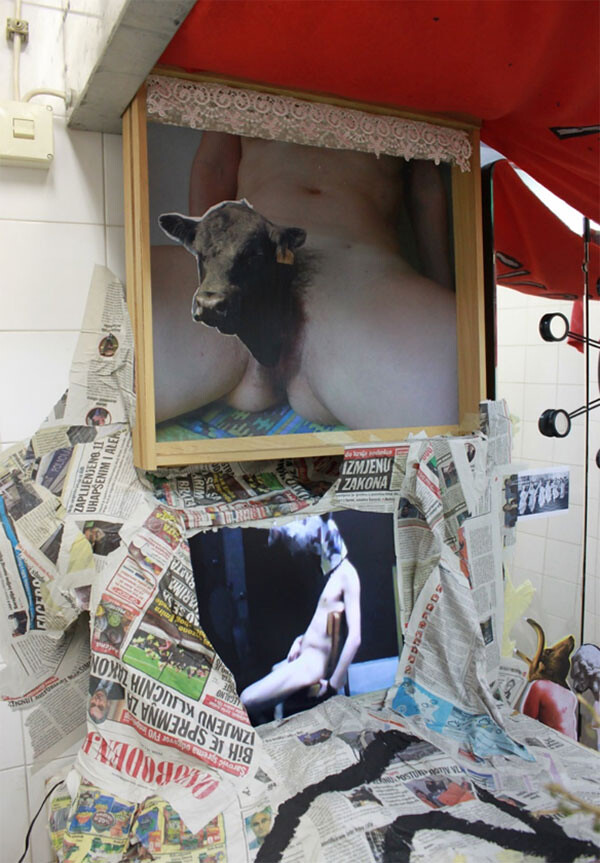

Nikolay Oleynikov, Oslobodenje: The Burlesque Museum, 2015. Installation views from Konjic Biennial, Bosnia and Herzegovina.
Indeed, art is closely linked to both witchcraft and comradeship. Let me refer to the works of my comrade Nikolay Oleynikov, of the group Chto Delat, who paints weird, monstrous collective bodies that shatter the continuity of nature and portray strange interspecies alliances. At his 2015 installation Oslobodenje: The Burlesque Museum, held in Tito’s bunker in the mountains near Sarajevo, a canvas in a modest wooden frame depicted a big Courbet-like vagina, from which emerged a realistic brown bullhead with a yellow tag in its ear. In another canvas (Romantic Collection, 2013), a penis ended in a mad dog’s head, which barked while its entire body was being masturbated. In other canvases, a person’s face was replaced with an animal’s head, with a flower, with something or someone else. “Who are all these characters?” I asked Nikolay. “They are folks,” he replied. These motley folks gathered together transgender dancers, bulls, philosophers, horses, cats and dogs, girls, wolves, roses, fingers, spirits and ghosts, vampires, and other living, dead, and of course undead creatures. Brecht, Lenin, Gramsci, and Hegel rose from their graves and took their places among a utopian group of “folks.”27
In this impersonal multiplicity, there is no one. What does this “no one” mean? It means a structural impossibility for “one” to be. A comrade is never alone—not in the trivial sense that there is always someone else around, but in the more radical sense that you are always many. You are Legion. This is how you succeed in “the fine art of not getting arrested,” persecuted, or burned alive by the inquisitors of your age. When you are many, you turn your back to the police officer and disappear. Comradeship creates a shield against the witch hunters who will try to catch us one by one, but who will never destroy the whole set of alliances that make up the Great Sorcery International. You know what I mean.
When the officer approached the bookshelves, Lenin kindly offered him a stool, so that the policemen had to start searching from the top, whereas all illegal books were stored on the bottom shelf. By the time the policemen finally approached the bottom shelf, he was too tired and did not find anything illicit.
In order to deceive the guard while writing revolutionary texts from jail, Lenin used milk as ink and bread as an inkwell. When the guard would come in, Lenin would quickly eat the inkwell.
For example, see the epic children’s poem by Alexander Tvardovsky (1938) and the short story by Mikhail Zoshchenko (1940) with the same title, Lenin i Pechnik (Lenin and the Stoveman). The stories are similar: when Lenin is already head of the socialist state, he meets a village stoveman who does not recognize him and is rude to him. After learning that he was in fact Lenin, the man lives in fear; at some point he is brought to Lenin’s house to fix the stove. Lenin treats him as a guest and offers him a cup of tea.
Lenin ventured into the forest to hunt the fox, but after the beautiful animal looked into Lenin’s eyes, he decided not to shoot it.
See →.
Silvia Federici, Caliban and the Witch: Women, the Body and Primitive Accumulation (Autonomedia, 2009), 11.
Federici, Caliban and the Witch, 141.
Michel Foucault, History of Madness, trans. Jean Khalfa and Jonathan Murphy (Routledge, 2006).
Fedrici, Caliban and the Witch, 143. Emphasis in original.
Paul Lafargue, The Right To Be Lazy →.
Federici, Caliban and the Witch, 141–42. Emphasis in original.
Federico Campagna, Technic and Magic: The Reconstruction of Reality (Bloomsbury Academic, 2018), 5–6.
Campagna,Technic and Magic, 10.
Gilles Deleuze and Felix Guattari, A Thousand Plateaus: Capitalism and Schizophrenia (Continuum, 2004), 271.
Deleuze and Guattari, A Thousand Plateaus, 271.
Oxana Timofeeva, “Imagine There’s No Void,” Filozofski Vestnik 34, no. 2 (2013) →.
Ronald Boer, Lenin, Religion, and Theology (Palgrave Macmillan, 2013), 141.
Vladimir I. Lenin, “Speech at a Plenary Meeting of the Moscow Soviet of Workers’ and Peasants’ Deputies,” February 28, 1921, in Collected Works, vol. 32 (Progress Publishers), 147–59.
Vladimir I. Lenin, Revolution at the Gate: A Selection of Writings from February to October 1917, ed. Slavoj Žižek (Verso, 2002), 16.
Vladimir I. Lenin, Two Tactics of Social-Democracy in the Democratic Revolution, 1905 →.
Boer, Lenin, Religion, and Theology, 139.
Lars T. Lih, “Scotching the Myths About Lenin’s ‘What Is to Be Done,’” Links, October 21, 2010 →.
Lih, “Scotching the Myths About Lenin’s ‘What Is to Be Done.’”
Jodi Dean, “Four Theses on the Comrade,” e-flux journal no. 86 (November 2017) →.
Antonin Artaud, The Theatre and Its Double, trans Mary Caroline Richards (Groove Press, 1958), 31–32.
Georges Bataille, “The Sorcerer’s Apprentice, ” in Visions of Excess: Selected Writings, 1927–1939, trans. Allan Stoekl (University of Minnesota Press, 1985), 223 →.
Oxana Timofeeva and Nikolay Oleynikov, “A Pack of Folks,” Rethinking Marxism 28, no. 3–4 (2016), 500–22.
